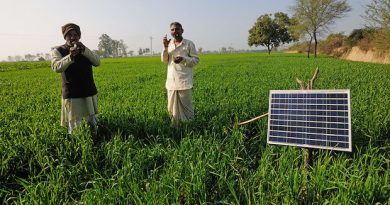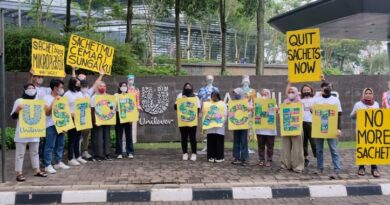IIED Paper: New Ways To Channel Climate Fund Crucial To Meet Paris Agreement
The latest research by IIED released at the One Planet Summit in Nairobi makes a strong case for ways that climate money could be used to actually make an effect on climate change

The One Planet Summit, is hosted by French President Emmanuel Macron and Kenya’s President Uhuru Kenyatta in Nairobi, today to help accelerate and focus attention on climate investments in line with the Paris Agreement.
New research called ‘Money where it matters: designing funds for the frontier’, by the International Institute for Environment and Development (IIED), sets out how a fundamental reform of the way climate finance is distributed can make sure it reaches the local level and meet the needs of growing numbers of people living in the poorest and most vulnerable countries.
“With only US$1 in every US$10 committed from climate funds for local level climate action, climate finance is failing to get money where it matters. We need to reimagine the climate finance system.”
The paper investigates the flow of finance from primary donor to local actor and presents a new framework to get more finance to local institutions to tackle the drivers of poverty, resource degradation and climate change. It also sets out the ways in which primary donors, global funds and financial intermediaries can help make this reimagined climate finance system a reality.
The paper elaborates how Climate finance is failing to tackle the drivers of vulnerability in communities facing chronic poverty, resource degradation and climate change. The research builds on earlier work and reviews four frontier funds in Brazil, Thailand and Zimbabwe that grew out of social movements and are effective in channelling money to the forefront of climate action.Four case studies:
- The Dema Fund, which supports indigenous peoples, women, Afro-Brazilians and subsistence farmers in the Brazilian Amazon
- The Babaçu Fund, which supports traditional nut collectors in northern Brazil
- The Gungano Urban Poor Fund supports low-income urban households in Zimbabwe
- The Tree Bank Foundation supports smallholder farmers in Thailand.
Less than 10% of international climate finance is being committed to the local level. Funds’ over-dependence on such institutions as the World Bank and UN agencies for distributing money committed under the Paris Agreement means, too often, finance is focused on short-term projects. These are designed by distant, uninvolved experts and, as a result, can miss local priorities and the flexibility to respond both to rapidly changing needs and new opportunities.
Clare Shakya, Director of Climate Change at the International Institute for Environment and Development (IIED) and one of the report’s authors, said: “This meeting is an important opportunity for governments and donors to make critical changes to a system that too often is more of an obstacle than solution. Making sure climate finance reaches the women, children and men who need it most, is critical to achieving the Paris Agreement’s targets. By strengthening local institutions and making sure they are involved at every step, climate finance can have the agility, responsiveness and relevance necessary to help communities thrive in the face of climate change and keep temperature rise below 1.5 °C above pre-industrial levels.”
Also, according to UNEP, donors and global funds have only committed US$22 billion to adaptation, whereas $140-300 billion is needed annually by 2030 in order to meet the Paris Agreement’s commitment for balanced support for adaptation and mitigation projects.
One more cause of concern is that a significant proportion of the money is spent on separate administration costs, which diverts the precious fund away from its purpose to tackle climate change. The four cases presented in the research demonstrate that there are effective alternatives to the current dependence on multilateral banks and other international bodies.
IIED estimates less than 10% of the US$17 billion climate finance committed from international climate funds between 2003 and 2016 was prioritised for local-level activities. Committing these funds to every level – national, regional and local – is crucial. The imbalance needs to be addressed with more of this money channelled to the local level. This analysis is of dedicated climate funds which is only 7% of total climate finance over this period, as the rest of the climate finance is not sufficiently transparent to be analysed. Greater transparency is needed to be able to track the effectiveness of climate finance.
 |
Aggregating local climate action: high transaction costs of overseeing the performance of many small projects and engaging with distributed delivery partners prevent large funders and intermediaries from investing in local climate action. Platforms that aggregate the impact of small projects make oversight easier, while disaggregating finance to the local level improves effectiveness. Institutions need systems to channel climate finance to local partners effectively and efficiently while providing assurance on the climate benefits delivered. |
 |
Building trust and shared understanding of risk: the distance and limited contact between finance providers and local institutions limit trust and create asymmetries in the distribution of risk. Innovations in financial structure and management can increase trust between stakeholders and make it easier for local institutions to access climate finance. Stronger upward (to donors and financiers) and downward (to citizens) accountability increases oversight and provides assurance that money is spent well. |
 |
Shifting incentives through setting direction and rules: investments in local climate action are most effective when governments support communities’ resource rights and create governance platforms with local actors, particularly women and other excluded groups. Mechanisms that effectively engage local people in decision making stimulate more supportive policy and regulation, enable local finance flows and secure clear rights to land and natural resources. |
 |
Building for the long term and recognising short-term capabilities: building local actors’ practical and strategic capabilities is essential for developing effective local responses that address climate change, resource degradation and poverty. Stronger capabilities and transparent local systems build trust and ensure local leaders and communities have the skills they need to deliver climate action that makes a difference and the strategic capacity to achieve scale. |




